-
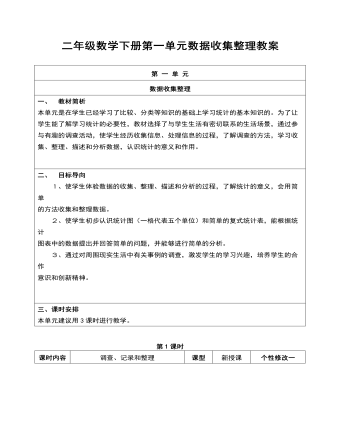
二年级数学下册第一单元数据收集整理教案
问题情景,导入新课1、多媒体课件出示例1主题图,问:图上的小朋友在干什么?你们测量过体重吗?测量了几次?读一年级刚入学时,你测量的体重是多少?(学生自由汇报各自的体重情况)怎样才能让大家一看就明白我们班所有人的体重情况呢?二、活动体验,探究新知1、电脑出示统计表(1): 体重(千克)15以下16~20 21~25 26~30 31以上人数 师:现在我们就用“正”字记录法来统计一下刚入学时的体重(集体活动)2、活动结束后,师生共同将收集的数据整理后填入表格中。3、二年级时,我们的体重有什么变化呢? 电脑出示统计表(2) 体重(千克)15以下16~20 21~25 26~30 31以上人数 集体进行统计活动,并将结果填入表中。4、讨论:如果想把两年的体重数据填入一个统计表中,该如何表示呢? 学生讨论后,在黑板上出示表格(3):(单位:千克)
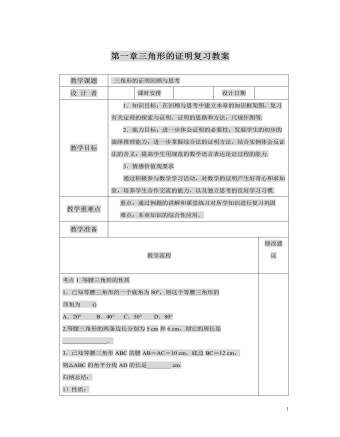
北师大初中八年级数学下册第一章复习教案
1.知识目标:在回顾与思考中建立本章的知识框架图,复习有关定理的探索与证明,证明的思路和方法,尺规作图等.2.能力目标:进一步体会证明的必要性,发展学生的初步的演绎推理能力;进一步掌握综合法的证明方法,结合实例体会反证法的含义;提高学生用规范的数学语言表达论证过程的能力.3.情感价值观要求通过积极参与数学学习活动,对数学的证明产生好奇心和求知欲,培养学生合作交流的能力,以及独立思考的良好学习习惯.重点:通过例题的讲解和课堂练习对所学知识进行复习巩固难点:本章知识的综合性应用。【归纳总结】(1) 定义: 三条边都相等 的三角形是等边三角形。(2)性质:①三个内角都等于60度,三条边都相等②具有等腰三角形的一切性质。

北师大初中九年级数学下册第一章复习教案
一、本章知识要点: 1、锐角三角函数的概念; 2、解直角三角形。二、本章教材分析: (一).使学生正确理解和掌握三角函数的定义,才能正确理解和掌握直角三角形中边与角的相互关系,进而才能利用直角三角形的边与角的相互关系去解直角三角形,因此三角形函数定义既是本章的重点又是理解本章知识的关键,而且也是本章知识的难点。如何解决这一关键问题,教材采取了以下的教学步骤:1. 从实际中提出问题,如修建扬水站的实例,这一实例可归结为已知RtΔ的一个锐角和斜边求已知角的对边的问题。显然用勾股定理和直角三角形两个锐角互余中的边与边或角与角的关系无法解出了,因此需要进一步来研究直角三角形中边与角的相互关系。2. 教材又采取了从特殊到一般的研究方法利用学生的旧知识,以含30°、45°的直角三角形为例:揭示了直角三角形中一个锐角确定为30°时,那么这角的对边与斜边之比就确定比值为1:2。
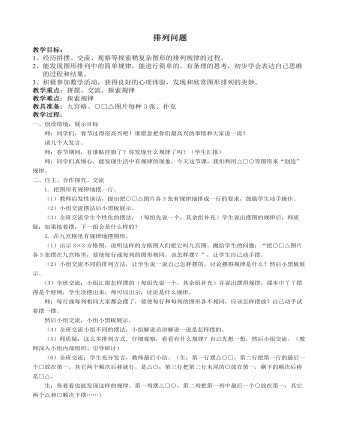
冀教版二年级数学下册排列问题教案
1.自学文本出示书中情境图:有21架飞机要参加飞行表演,怎样飞呢?想请同学们帮忙设计编组方案,下面小组同学合作,用学具摆一摆,设计出自己的编组方案,看哪个小组设计的方案最多?学生小组合作,边摆学具边说方案。2.交流研讨哪组想到前面来汇报一下你们制定的飞行方案?(不必强调平均分,如有小组同学说出每组有7(3)架,可以分成3(7)组,或每7(3)架一组,可以分成3(7)组,老师在给予肯定的同时可以问其它小组摆法一样吗?之后板书算式:21÷7=3,21÷3=7。如果学生没说出平均分,老师可引导说:有时表演的每组也可同样多)
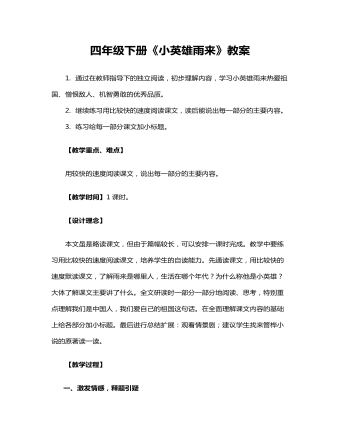
四年级下册《小英雄雨来》教案
1. 通过在教师指导下的独立阅读,初步理解内容,学习小英雄雨来热爱祖国、憎恨敌人、机智勇敢的优秀品质。2. 继续练习用比较快的速度阅读课文,读后能说出每一部分的主要内容。3. 练习给每一部分课文加小标题。【教学重点、难点】用较快的速度阅读课文,说出每一部分的主要内容。【教学时间】1课时。【设计理念】本文虽是略读课文,但由于篇幅较长,可以安排一课时完成。教学中要练习用比较快的速度阅读课文,培养学生的自读能力。先通读课文,用比较快的速度默读课文,了解雨来是哪里人,生活在哪个年代?为什么称他是小英雄?大体了解课文主要讲了什么。全文研读时一部分一部分地阅读、思考,特别重点理解我们是中国人,我们爱自己的祖国这句话。在全面理解课文内容的基础上给各部分加小标题。最后进行总结扩展:观看情景剧;建议学生找来管桦小说的原著读一读。【教学过程】一、激发情感,释题引疑1、课件演示:小雨来与鬼子斗争的片断。问:你们想认识这位小英雄吗?2、出示课题:(1) 理解课题:齐读课题你从中知道了什么?小——指的是雨来的年龄小,是一个少年。英雄——指的“是雨来的特点。雨来——课文中的主人公。课题表现出文章的中心——英雄。(2) 引导到学生质疑:看到课题后,你还想知道什么?(为什么称雨来是小英雄?)(从课文中的哪些地方可以看出雨来是一位小英雄?)
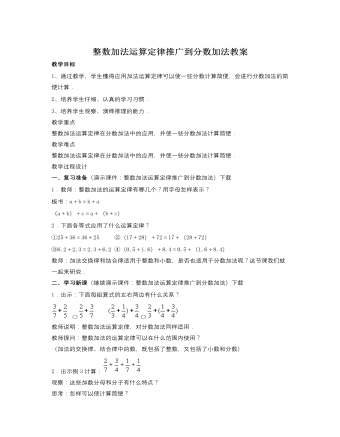
人教版新课标小学数学五年级下册整数加法运算定律推广到分数加法教案
教学目标1、通过教学,学生懂得应用加法运算定律可以使一些分数计算简便,会进行分数加法的简便计算.2、培养学生仔细、认真的学习习惯.3、培养学生观察、演绎推理的能力.教学重点整数加法运算定律在分数加法中的应用,并使一些分数加法计算简便.教学难点整数加法运算定律在分数加法中的应用,并使一些分数加法计算简便.教学过程设计一、复习准备(演示课件:整数加法运算定律推广到分数加法)下载1.教师:整数加法的运算定律有哪几个?用字母怎样表示?板书:a+b=b+a(a+b)+c=a+(b+c)2.下面各等式应用了什么运算定律?①25+36=36+25 ②(17+28)+72=17+(28+72)③6.2+2.3=2.3+6.2 ④(0.5+1.6)+8.4=0.5+(1.6+8.4)教师:加法交换律和结合律适用于整数和小数,是否也适用于分数加法呢?这节课我们就一起来研究.二、学习新课(继续演示课件:整数加法运算定律推广到分数加法)下载1.出示:下面每组算式的左右两边有什么关系?
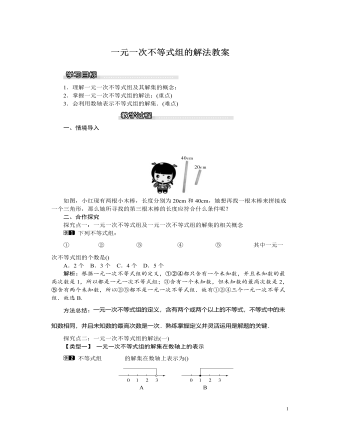
北师大初中八年级数学下册一元一次不等式组的解法教案
把解集在数轴上表示出来,并将解集中的整数解写出来.解析:分别计算出两个不等式的解集,再根据大小小大中间找确定不等式组的解集,再找出解集范围内的整数即可.解:x+23<1 ①,2(1-x)≤5 ②,由①得x<1,由②得x≥-32,∴不等式组的解集为-32≤x<1.则不等式组的整数解为-1,0.方法总结:此题主要考查了一元一次不等式组的解法,解决此类问题的关键在于正确解得不等式组或不等式的解集,然后再根据题目中对于解集的限制得到下一步所需要的条件,再根据得到的条件进而求得不等式组的整数解.三、板书设计一元一次不等式组概念解法不等式组的解集利用数轴确定解集利用口诀确定解集解一元一次不等式组是建立在解一元一次不等式的基础之上.解不等式组时,先解每一个不等式,再确定各个不等式组的解集的公共部分.
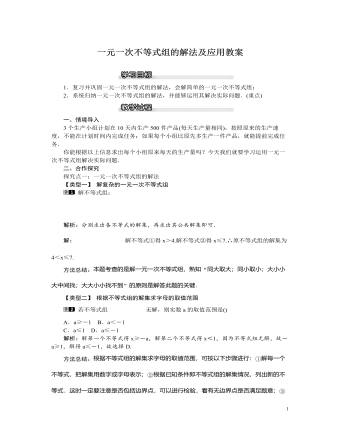
北师大初中八年级数学下册一元一次不等式组的解法及应用教案
安装及运输费用为600x+800(12-x),根据题意得4000x+3000(12-x)≤40000,600x+800(12-x)≤9200.解得2≤x≤4,由于x取整数,所以x=2,3,4.答:有三种方案:①购买甲种设备2台,乙种设备10台;②购买甲种设备3台,乙种设备9台;③购买甲种设备4台,乙种设备8台.方法总结:列不等式组解应用题时,一般只设一个未知数,找出两个或两个以上的不等关系,相应地列出两个或两个以上的不等式组成不等式组求解.在实际问题中,大部分情况下应求整数解.三、板书设计1.一元一次不等式组的解法2.一元一次不等式组的实际应用利用一元一次不等式组解应用题关键是找出所有可能表达题意的不等关系,再根据各个不等关系列成相应的不等式,组成不等式组.在教学时要让学生养成检验的习惯,感受运用数学知识解决问题的过程,提高实际操作能力.
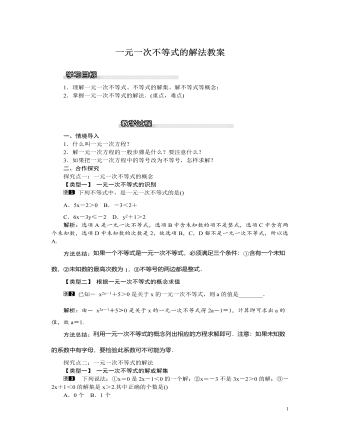
北师大初中八年级数学下册一元一次不等式的解法教案
方法总结:已知解集求字母系数的值,通常是先解含有字母的不等式,再利用解集唯一性列方程求字母的值.解题过程体现了方程思想.三、板书设计1.一元一次不等式的概念2.解一元一次不等式的基本步骤:(1)去分母;(2)去括号;(3)移项;(4)合并同类项;(5)两边都除以未知数的系数.本节课通过类比一元一次方程的解法得到一元一次不等式的解法,让学生感受到解一元一次不等式与解一元一次方程只是在两边都除以未知数的系数这一步时有所不同.如果这个系数是正数,不等号的方向不变;如果这个系数是负数,不等号的方向改变.这也是这节课学生容易出错的地方.教学时要大胆放手,不要怕学生出错,通过学生犯的错误引起学生注意,理解产生错误的原因,以便在以后的学习中避免出错.

人教版新目标初中英语七年级下册How was your weekend教案2篇
Teaching Goal:1. General aims:Talk about recent past events2. Particular aims:A. Language Focus.Talk about recent past events and think of the past events.B. Language goalsHow was….?It was …What did …do over the weekend?C. Language structures:(1). How was your weekend? I was great. Pay attention to no form.(2). What did you do over the weekend? I played soccer. We went to the beach.D. Useful words and phrases:Words: was, did, went, beach, over, project, test, wasn’t, false, number, geography, spend, week, most, mixture, their, had, little, cook, read, saw, change, everyone, sit, sat, no, anythingPhrases: did one’s homework, played soccer, cleaned my room, went to the beach, played tennis, went to the movies, on Saturday morning, over the weekend, cook … for, what about, do some reading, have a party, talk show, go shoppingE. Grammar language:Present simple past tenseRegular and irregular verbsF. Learning strategies:Tour and holidaysG. Interdiscipinary:H. Emotion and manner:Teaching time: 5 periodsTeaching procedures:Period One教学步骤、时间 教师活动 学生活动 媒体应用Step 1Free talk 3’ Ask some questions like:Who’s on duty today?What’s the weather like? Answer and talk about something.让同学们回答下列问题1. Do you like weekend? (Let some students answer)It takes them three minutes to talk about the question.2. Why do you like weekend? (let the students answer) Most of the students like the weekend此时教师用汉语问:“在周末期间问你干了什么?这句话用英语这么回答?Let the students guess.At last the teacher give them right answer3. What did you do over the weekend?(板书、学习)

人教版新目标初中英语七年级下册What does he look like教案3篇
所需要用到的句子:Who is that?That is Jack. I like him.Why do you like him?I like him because he is interesting.Task 4: 设计理想中的人类Step one: 设计理想中的人类的外貌。把全班同学分成若干小组,学生可以边说边在纸上画出他们的模样。Step two: 设计理想中人类的性格。学生们可以把那些能描述性格的单词写在图画的旁边。Step three: 每组选出一名同学,其他同组同学提问,他作简单回答,并说明原因。所需用到的句子:What does he or she look like?He or she ...What is he or she like?He or she is ...Why?Because ...Task 5: 挑战性活动调查性格是天生的还是后天形成的,让每个同学回家去调查一下自己成长过程中性格是否有变化,具体是怎样的,为什么会这样? Teaching Aims:1. Enable students to have a general understanding of how to talk about people's physical appearance.2. Enable students to tackle some essential vocabularies and patterns about describing people. Provide them with necessary skills and methods.3. Create various chances for students to describe the persons they're familiar with, such as classmates, family members, teachers, idols, etc.

人教版新目标初中英语七年级下册Don’t eat in class教案2篇
Don’t fight. =You can’t fight. (板书,教读)教师把这些句子板书在黑板上,并请学生大声整齐地读祈使句和“can’t”句型,并让学生注意两种句型表达形式的不同和转换,“Don’t …=You can’t…”;并对学生说:These are our school rules. (板书,教读) You can’t break the school rules. Don’t break the school rules.(板书,教读)步骤3 :Practicea. T: Now, each of the students is breaking one of these rules.Please finish 1a.学生看图,完成1a的内容,检查答案并大声朗读校规。b. 听录音,完成1b,选出四位学生都违反了哪条校规;听之前,学生要读会英文名。c. 请两位学生朗读1c部分的句型;要求学生两人一组对话表演,SA扮演外校转来新生,SB告知本校校规。(学生可经过讨论,多说出他们想到的校规,不必只限于书上;教师应给予帮助)2) 第二课时(2a~4)步骤1 :warming up of revisionT: What are the rules at your school?学生使用“can”或祈使句表达各条校规;其中老师可引出“eat in the cafeteria outside”的表达。步骤2 :Practicea.T: Christina is an exchange student. She doesn’t know the rules. Let’s listen, what activities they’re talking about?学生听第一遍时,完成2a;第二遍时,完成2b;b. 请学生领读2c部分,看着2a完成的表格,理解2c活动的要求;分成小组针对2a进行问答;

人教版新目标初中英语七年级下册I ’d like some noodles教案
教学过程Step 1: warming-up Sing a song---------“food and drink” Step 2: Revision1 Dictation2 Revise: What kind of noodles would you like?I’d like …What size bowl of noodles would you like?I’d like…Step 3: Presentation1 show pictures of food, ask students say the words.2 Students read the newspaper ad in 3a. Fill in blanks with words in the box. Then read the ad together, the teacher explains some difficult language points.3 Check the answers Step 4 PracticeAsk students to finish 3b in the same way according to 3a. Students read the short passage and fill in the blanks .At last, check the answers.Step 5 productionAsk students to write their own ad for dumplings, noodles, drinks, and other foods they know. Then ask students to read their partner’s ad. Then order food and drink from their partner.Step 6 Home workGroup work – make an ad about “food and drink”

人教版新目标初中英语七年级下册It’s raining教案2篇
1 Each group choose one place to describe and what you are doing in it Choose one place, and describe what they are doing 2 Move around the room and give suggestions Talk about it and write it down 3 Ask one to show their works and act it Choose one of each group to make a report 4 Evaluate the best group and the best reporter Choose the best one Homework Ask your friends their ideal place and write about it教学反思:新课程标准中强调学生在课堂中的主体地位,在综合课中他们的主体地位就更加突出。在各个活动中给不同程度的学生不同层次的任务,让各层面的学生都有表现发挥的机会,从而产生对英语的兴趣。使用照片图片多媒体来辅助教学,效果更好。同时让了解其他国家风景,风俗的同学介绍ideal place,增加学生的背景知知识,实现跨学科交流的目的。教案点评:采用任务型教学模式,在各个活动中给不同程度的学生不同层次的任务,让各层面的学生都有表现发挥的机会,从而产生对英语的兴趣。使用照片图片多媒体来辅助教学,效果更好。让了解其他国家风景,风俗的同学介绍ideal place,增加学生的背景知识,实现跨学科交流的目的。

人教版新目标初中英语七年级下册What do you think of game shows教案
五、教学Section B-2c1. Pair work: What do you think of the belt/sunglasses/…? What does your father/mother/… think of your scarf/belt…?2. Group work(1). Teacher shows some different kinds of school uniforms (制服)and asks : “ What do you think of your school uniforms? If you have a chance to choose your school uniforms, what kind would you like to choose?”(2). Discuss in groups.(3).Get some Ss to report in class.说明:这一步旨在让学生运用已有的语言知识谈论对事物的看法和意见,并简单阐明理由,培养学生的主动思维能力和运用英语的能力。六、教学拓展调查电视节目的收视率任务:调查你周围的人对现在各种电视节目的反响。活动过程:1.教师布置任务,让学生调查周围的人(包括他的亲戚朋友和邻居)喜欢收看哪方面的电视节目。2.学生进行调查活动,运用本单元所学的句型What do you think of….? (Why?)What's your favorite game shows?What do you think of talk show?I doesn’t mind it.I like it.I love it.I can’t stand it.3.记录下排在前10位的TV Program,填写调查表,比较其收视率。

人教版新目标初中英语七年级下册Where did you go on vacation教案
句型: Where did you go on vacation? I went to summer camp.Did she go to Central Park?Yes,she did.No, she didn’t语法:一般过去时特殊疑问句、一般疑问句及肯、否定回答。课时安排4课时第一课时:Section A:la,1b,lc,2a,2b,2c 第二课时:Section A:3a,3b,4第三课时:Section B:1,2a,2b,2c第四课时:Section B:3a,3b,3c,4 and Self Check第一课时教学目标掌握描写假期生活的形容词。假期里自己所做事情的简单表达。谈论假期做的事情及当时情况。谈论假期时旅游的天气,旅游者以及食物等。教学过程一、导入播放一首英文歌曲:Let’s travel 说明:通过让学生听节奏欢快迪斯尼英语歌曲Let’s travel.引入本节课谈论的话题vacation and travel. 让歌曲使学生的思维活跃,增强课堂气氛,激发学生提高学习英语的兴趣。T:How is the trip ?Ss : It’s pretty good/ happy/exciting /relaxing/busy/dangerous/ fantastic说明:这个问题是为了操练形容词。建议让多个Ss作答。鼓励他们用不同的形容词。上述个别形容词本应在第二课时中出现,但可以在warming-up中第一次非正式出现。这些形容词也可在老师的评价语中适时出现,以加深学生对词汇的印象。

人教版新目标初中英语八年级下册Have you ever been to an amusement park教案
(1)Have you ever been to …? Yes, I have. / Yes, I have ever been to …No, I haven’t. / No, I have never been to …(2)When did you go there? I went there last year. (3)I have never been to a water park. Neither have I. I have ever been to an amusement park. So have I. (4)How long have you been studying English? I’ve been studying English since nine o’clock. I’ve been studying English since I came back home. I’ve been studying English for five hours. (5)What’s that? It’s an amusement park in Japan. I’ve never been to an amusement park like it before. It’s fun to learn another language. Let’s go tonight. Isn’t this great?space museum, amusement park, water park, South America, Peru, Holland, European culture, tour guide, flight attendant, musical instrument, more than, be from, get to, take lessons, neither, discover, graduate, change

人教版新目标初中英语八年级下册If you go to the party, you’ll have a great time教案2篇
区分宾语从句、定于从句和状语从句宾语从句和状语从句,都叫做主从复合句。宾语从句主要是中考必考的,是初中阶段必掌握的从句,宾语从句主要是掌握三要素,所谓宾语从句,就是宾语在主从复合句当中充当宾语的一个句子,叫做宾语从句。主句的谓语动词是及物动词,后面如果是词或者是短语的话,是简单句,如果是句子的话,肯定是宾语从句。I know that he good at English.就是宾语从句,三要素,一要素是要注意连词,连词一共学了三类连词,一类连词是that口语当中可以省略,就像刚才说的那一句,I hear he is good at English.还有疑问代词、疑问副词,how where when,疑问代词、疑问副词。还有一类连词weather是否的意思,不是状语从句当中的如果,这一定要和如果区分开,这是是否。I don't know if he interested at English。宾语从句要注意if是连词。第二要素是语序,要用陈述举语序。比如说你家有几口人,我们都说How many people are there in you family?但是这是简单句,一旦说成宾语从句,你可以告诉我你家有几口人吗?Could you tell me how many people there are in you family ?

人教版新目标初中英语八年级下册It’s a nice day, isn’t it教案2篇
"Hello! Welcome to English class! Introduce yourself. Meet your new classmates." That's what the teacher says. What do you say? "Oh no!" It can be difficult talking to new people. But it can be fun, and you can make friends. How do you do it? Make small talk. Small talk is polite conversation. "Wang Nan is a great pingpang player, isn't she?" "I'd love to meet her, wouldn't you?" "It's been raining a lot, hasn't it?" Tag questions are a form of polite speech. To make small talk successfully, you should know how to make them. You should also know what topics to talk about. Try to learn this unit carefully. The next time you're in English class, you'll find out. Making small talk's easy, isn't it? (“你好!欢迎你!请做一下自我介绍。认识一下你的新同学。”通常在课上老师会这样说。你会说什么呢?“噢,不!”与陌生人谈话太困难了。但是这也很有意思,并且你还能交到朋友。你该怎么做呢?闲聊。闲聊指得是礼貌的对话。“王楠是一个很棒的乒乓球运动员,不是吗?”“我希望自己能认识她,你呢?“今年的雨水很多,不是吗?”反意疑问句是一种礼貌用语。为了使得谈话成功,你应该知道怎样去进行闲聊。你还应该知道与不同的人该谈论什么样的话题。认真的学习这个单元吧,下次在英语课上,你会发现与大家展开谈话是一件很容易的事情,不信我们来试试。)

人教版新目标初中英语八年级下册How long have you been collecting shells教案2篇
Step Ⅱ Show the new words on the screen and teach the new words. Read the new words to students and ask them to repeat.Step Ⅲ 3aThis activity introduces new vocabulary and provides reading practice using the target language.In this activity first look at the four pictures.T: What can you see in the pictures?Ss: Four snow globes.T: Right. There are four snow globes in the pictures. And what are they?Ss: They are a monster, two polar bears, two penguins and a birthday cake.Write these words on the blackboard: snow globe; monster; polar bear; penguin and birthday cake. Read them to the class and ask students to repeat each one. Make sure students understand each word.Use a computer to show the E-mail message on the screen and read the message to students.Get students to read the e-mail on their own, and then draw lines connecting each snow globe and its description.Correct the answers.AnswersA line should connect each snow globe picture with the words that describe it in the letter.Step Ⅳ 3bThis activity provides writing practice using the target language.First review Activity 2a on Page 47.Then ask students to complete the message according to Activity 2a.Some partial sentences are given to students. Write about one person's collection.When students work, walk around the room checking the progress and offering help as needed.When they finish, ask some students to read their messages to the class.

